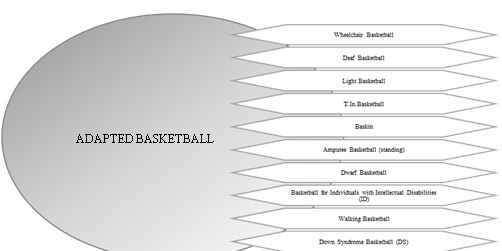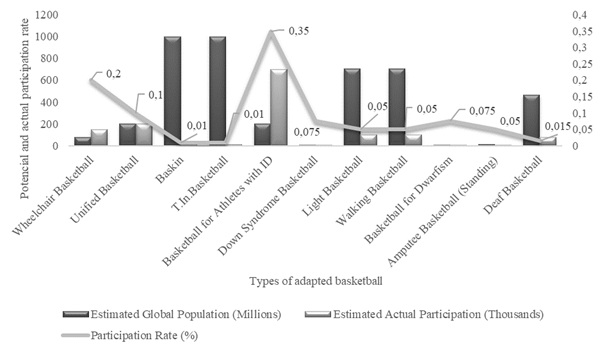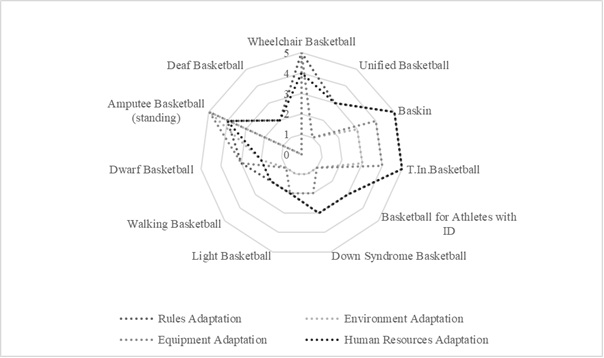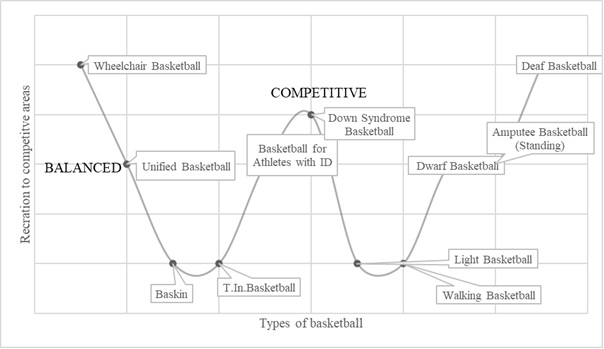Stefka Djobova
Ivelina Kirilova
National Sports Academy “Vassil Levski”
https://doi.org/10.53656/str2025-2s-4-the
Abstract. This pilot study aims to comprehensively understand inclusion in adapted basketball and illuminate the path forward. A comparative quantitative methodology was employed, using predefined criteria such as accessibility, adaptation levels, and social inclusion. Mathematical-statistical analysis, descriptive statistics, and contextual evaluation were applied to assess participation rates, accessibility challenges, and community support. Data were sourced from international sports organizations. The methodology ensures a robust examination of structural, cultural, and logistical barriers, contributing to a deeper understanding of accessibility and inclusivity in adapted sports globally. Each variant of adapted basketball aims to ensure that everyone, regardless of their physical, cognitive or sensory abilities, can participate in and enjoy the game. Adapted basketball not only highlights athletic excellence but can also serve as a powerful tool for empowering individuals with disabilities, thereby facilitating their full inclusion as an integral part of society.
Keywords: adapted basketball; inclusion; unified sport
Introduction
The landscape of sports for persons with disabilities has transformed significantly, shifting from a rehabilitative activity to a platform that showcases the abilities and resilience of athletes with disabilities. Adapted basketball (AB) stands at the forefront of this movement, embodying principles of equality, accessibility, and opportunity. It reflects a broader societal shift towards inclusivity and the recognition of the rights and abilities of individuals with disabilities.
Historically, numerous barriers have hindered the inclusion of persons with disabilities in sports, including inadequate facilities, accessibility challenges, and societal attitudes (Djobova et al. 2020). However, sustained efforts by advocates, athletes, and organizations have driven progress, resulting in the development of adapted sports, such as basketball. These adaptations, such as Wheelchair Basketball and Unified Basketball, demonstrate the sport’s versatility in meeting diverse needs, fostering social cohesion, and improving self-esteem among participants. The philosophy behind AB is rooted in values of diversity, equity, and mutual respect, making it a tool for empowerment and societal change.
Despite these advancements, challenges remain. Many AB forms still face structural barriers, including the need for more accessible facilities and equipment, and cultural barriers, such as persistent stigmas and limited awareness of the capabilities of individuals with disabilities. Overcoming these challenges requires a multifaceted approach that combines policy reform, community engagement, and advocacy to create more inclusive sports environments. AB transcends the game itself, symbolizing the ongoing fight for equality, empowerment, and recognition for individuals with disabilities. It offers valuable lessons for broader societal efforts to promote inclusivity and create environments where individuals are recognized for their abilities, not their disabilities.
This pilot study aims to provide a comprehensive understanding of the current state of inclusion in adapted basketball and illuminate the path forward.
Research methods
This study employs a comparative quantitative methodology to systematically assess the current state of inclusion across various types of adapted basketball. By utilizing predefined criteria and integrating mathematical-statistical analysis with contextual evaluation, the study provides a comprehensive understanding of inclusion within adapted basketball. The approach ensures rigor and consistency in analysing inclusion and accessibility.
The methods used in this study are as follows:
Comparative Classification: Adapted basketball types were systematically graded using a framework of criteria, including Scope of accessibility, Level of adaptation, Balance between competitive and recreational opportunities, Community acceptance and support, and Promotion of social inclusion. This allowed for categorization into recreational-focused, competitive-focused, and balanced basketball types.
The Contextual and Thematic Analysis: Broader cultural, societal, and infrastructural factors influencing inclusion were examined. These included barriers such as stigma around disabilities, costs of specialized equipment, and limited access to facilities, particularly in lower-income and rural areas.
Mathematical-Statistical Analysis: Descriptive Statistics: Key metrics, including participation rates, accessibility levels, and community support, were summarized to provide a clear picture of the current state of inclusion.
Sources of Data: Data were drawn from international sports organizations and governing bodies, including the International Wheelchair Basketball Federation (IWBF), Special Olympics, VIRTUS, and other academic and organizational reports. Participation rates and demographic data were also analysed to contextualize findings.
The author-created figures visually represent the findings of a comparative analysis conducted using predefined criteria, including scope of accessibility, adaptation level, competitive and recreational balance, community acceptance, and promotion of social inclusion. The figures synthesize insights from the authors’ evaluation and, where applicable, external data sources such as the World Health Organization, International Wheelchair Basketball Federation, Special Olympics, VIRTIS and others.
This methodological framework integrates quantitative analysis with contextual insights, ensuring a robust and comprehensive examination of inclusion in adapted basketball. By addressing structural, cultural, and logistical barriers, the study provides valuable insights for enhancing the accessibility and inclusivity of adapted sports worldwide.
Results
Various forms of adapted basketball have been developed to accommodate individuals with different types of disabilities, ensuring that everyone, regardless of physical, cognitive, or sensory abilities, can participate and enjoy the game (Fig. 1).

Figure 1. Types of adapted basketball
Physical disabilities are addressed by several modifications of AB. Wheelchair Basketball, designed for individuals with mobility impairments, focuses on enabling those who use wheelchairs to participate fully in the game through specialized equipment and rules (International Wheelchair Basketball Federation, n.d.). Amputee Basketball (Standing) allows athletes with limb amputations or other physical disabilities to play in a standing position, without wheelchairs, offering an alternative competitive format (Pryor 2018). Dwarf Basketball is tailored specifically for individuals with bone deformities, ensuring that the game is accessible to those with short stature by adapting equipment like hoop height (Dwarf Sports Association UK, n.d.). Walking Basketball targets individuals with mobility issues, including older adults 65+, by focusing on walking rather than running, reducing the physical strain typically associated with the game (Basketball NSW, n.d.). Light Basketball makes the sport accessible to individuals with physical limitations by using lighter balls and lower hoops, primarily focusing on recreational play. Sensory disabilities are addressed through Deaf Basketball, designed for individuals with hearing impairments (Deaf International Basketball Federation, n.d.). This adaptation incorporates sign language and visual cues to ensure effective communication and gameplay, making it possible for those with hearing disabilities to participate in the sport fully. Intellectual and cognitive disabilities are supported through a variety of basketball adaptations. SO Basketball and VIRTUS Basketball are designed for individuals with intellectual disabilities, offering opportunities for physical activity, social interaction, and skill development in a supportive environment (VIRTUS, n.d.). DS Basketball targets explicitly individuals with Down syndrome, offering a tailored version of the game that meets the unique needs of this group (Sports Union for athletes with Down Syndrome, n.d.).
Several forms of basketball promote inclusion across athletes with various disabilities. T.In.Basketball encourages participation from players with diverse physical and cognitive state, fostering teamwork and social inclusion. Likewise, Baskin is built from the ground up to be inclusive, allowing individuals with a wide range of physical and cognitive disabilities to play together (Baskin, n.d.). Unified Basketball promotes the cooperation of athletes with intellectual disabilities and athletes without disabilities (Unified Sports partners) on the same teams, fostering mutual understanding and teamwork.
The first explored criteria was scope of accessibility. The potential global reach of each type of AB and their actual participation rates were compared (Fig. 2).

Figure 2. Estimated Global Population vs Actual Participation in Adapted Basketball Types
We examined both the estimated global population of individuals with disabilities that each sport targets and the real-world participation rates. These rates may be affected by factors such as regional availability, infrastructure, awareness, and cultural attitudes toward sports for people with disabilities.
Basketball for Athletes with ID has the highest participation rate (~0.35%), indicating that programs like the Special Olympics and VIRTUS have made substantial progress in reaching this population. Wheelchair Basketball also shows a relatively higher participation rate (0.13% to 0.27%) than other AB types, likely due to its long-established presence and recognition.
Unified Basketball (SO) shows a moderate participation rate (~0.10%). Even though it is part of a large and well-recognized program, it still underperforms relative to its large potential population. DS Basketball (0.05% to 0.1%) and Dwarf Basketball (0.05% to 0.1%) both serve smaller populations, but their rates are still low due to a lack of specialized programs and global awareness. Light Basketball and Walking Basketball have low participation rates (~0.05%) despite a large target population (703mln) (World Health Organization 2011). This reflects a general lack of awareness and engagement among elderly populations.
Amputee Basketball (standing) shows a similarly low participation rate (~0.05%). Extremely Low Participation Rates have Baskin and T.In.Basketball is estimated to be less than 0.01%, despite its potential to serve 1 billion people globally (Baskin, n.d.). These quite newer forms of basketball have not yet gained international traction. Deaf Basketball also has a low participation rate (~0.01% to 0.02%) despite the large population of individuals with hearing impairments.
According to the adaptation level, we analysed four key factors: rules, environment, equipment, and human resources needed. Each factor presents the level of adaptations needed for the different populations and settings (Fig. 3).

Figure 3. Adaptation Levels of Types of Adapted Basketball
Wheelchair Basketball has high adaptation levels across all categories, especially in equipment and environment, due to the need for specialized wheelchairs and accessible courts. Baskin and T.In.Basketball has the highest overall adaptation scores, requiring complex rule modifications, specialized equipment, and significant human resources due to their inclusivity of various disabilities (CSEN Nazionale, 2015). Unified Basketball and Basketball for Athletes with ID show moderate adaptation levels, primarily requiring adaptations in coaching and rules, but less need for specialized equipment or environment changes (Special Olympics Inc, 2024). Walking Basketball, Light Basketball, and Deaf Basketball have the lowest adaptation levels across all categories, as they require only slight rule modifications and are designed for older adults with minimal changes in equipment or environment.
The balance between competitive and recreational elements in each type of AB plays a key role in determining its accessibility and the range of participants. Some types of AB lean heavily toward competitive play, with structured leagues and international competitions, while others are primarily recreational, focusing on inclusivity, fitness, and fun. Based on the criteria of internationally recognized governing bodies, structured competitions, formalized rulebooks, a focus on elite athlete development, observation and comparison of the official Strategic plans of the leading organisations, each type of AB can be classified into one of three categories: Recreational-focused, Balanced, or Competitive-focused (Fig. 4).

Figure 4. Competitive and recreational balance
Wheelchair Basketball is one of the most structured, competitive forms of AB, with a governing body, global competitions, and a focus on elite athlete performance. Almost at the same level is Deaf basketball. Unified Basketball strikes a balance between competitive and recreational elements (Unified Sports Models Comparison Chart, 2012). It has structured competitions and a governing body, but its core focus is on inclusion and participation. With the same focus, the basketball for Athletes with ID has both competitive and recreational elements. DS Basketball has some competitive opportunities through SUDS and IBA and the latest focus is largely on competitive opportunities. Dwarf Basketball leans toward balanced, with competitive elements like the World Dwarf Games, but overall, the focus is more on participation and inclusion.
Baskin is more recreational, as its presence outside Italy is limited. While it has a rulebook and some competitive elements, it lacks international recognition and competitions (Federazione Italiana Pallacanestro FIP, n.d.) Basketball is entirely recreational, without structured competitions, governing body, or pathways for elite athlete development. It prioritizes inclusion and community play (Djobova, Borukova 2015). Walking and Light Basketball are entirely recreational, with no structured competition or international recognition, focusing on fitness and community interaction.
In this research, community acceptance refers to how well each type of basketball is embraced by the general public, local communities, and the community with disabilities. Needed support includes the resources required for successful implementation, such as financial investment, specialized equipment, trained coaches, and support staff.
Wheelchair Basketball enjoys moderate to high levels of community acceptance, particularly in countries with established adaptive sports programs. Its inclusion in the Paralympic Games and national leagues has increased public familiarity, but participation rates remain moderate due to barriers such as the cost of specialized equipment and accessibility. Although the sport has strong organizational network, the level of support required is exceptionally high, particularly in terms of finances and logistic. Those demands can limit the sport’s reach in less resourced areas, thereby restricting its community acceptance despite its high visibility in certain contexts.
In contrast, Unified Basketball achieves high levels of community acceptance, due to its strong emphasis on inclusion. Widely recognized and supported by both the Special Olympics and FIBA, it benefits from high participation rates, particularly in schools and community centres. The sport is relatively easy to implement, requiring only standard basketball facilities and equipment, which keeps the support needs at a moderate level. These features make Unified Basketball one of the most accessible forms of AB. Its widespread integration into community programs reflects the sport’s successful alignment with social inclusion and public health goals.
Basketball for Athletes with Intellectual Disabilities (ID), have high community acceptance. The sport’s integration into SO events ensures strong participation rates and broad accessibility, as it generally uses standard basketball equipment and facilities. While the support required is moderate, due to trained coaches and support staff needed, the sport’s social impact is significant. It plays a crucial role in promoting the inclusion of individuals with ID in both settings, contributing to its high acceptance.
Baskin, on the other hand, has a more limited reach. While it is highly inclusive, accommodating players of all abilities, its popularity is concentrated largely in Italy, where it originated. Community acceptance is moderate, with slow international growth, largely because it requires adapted facilities and specialized equipment, such as lower hoops and different court zones, to accommodate players with diverse needs. These adaptations significantly increase the level of support required, making it harder for the sport to expand globally. Although Baskin’s inclusivity is one of its strengths, the high cost and logistical complexities in setting up programs have hindered its broader adoption, especially in areas without accessible infrastructure.
T.In.Basketball shares some of these challenges. Its focus on total inclusivity gives it potential for community acceptance, but the sport remains relatively unknown globally. Participation rates are modest, driven mainly by small, local initiatives. The sport’s adaptability to various disabilities requires moderate to high support, particularly for equipment and coaching resources. Like Baskin, the need for adaptations limits its growth and reduces its accessibility in less resourced communities. Despite its inclusive nature, T.In.Basketball has yet to achieve the same level of institutional support or public recognition as more established forms of AB.
DS Basketball faces more challenges in terms of community acceptance and support needs. Although the sport is highly inclusive for individuals with DS, it remains relatively niche, with limited awareness and participation rates. Special Olympics provide some level of institutional support, but specialized coaching and adapted programs are required, increasing the overall level of support needed. While this basketball has an important role within specific communities, its broader cultural impact and recognition remain limited compared to other adapted sports.
In the realm of recreational basketball, Light Basketball and Walking Basketball standout for their high community acceptance and low support needs. Both sports are widely embraced by older adults and communities that promote physical activity and well-being. These forms of basketball require minimal adaptation, using standard courts and basic equipment, which makes them highly accessible. The ease of implementation, combined with their focus on health and social interaction, explains their broad popularity. Light and Walking Basketball are excellent examples of how adapted sports can thrive with low levels of support, making them ideal for community health initiatives that target aging populations.
Dwarf Basketball occupies a more niche position, with moderate community acceptance. Although it enjoys support through events like the World Dwarf Games, participation rates remain relatively low, as the sport is largely confined to specific events and organizations such as Little People of America. The need for adapted equipment, such as lower hoops, increases the level of support required, which can limit its widespread adoption. While it plays a significant role within the dwarfism community, its broader recognition and accessibility are constrained by these support challenges.
Finally, Amputee Basketball (Standing) is an emerging sport that is gaining moderate levels of community acceptance. Public awareness is growing, particularly through the efforts of teams like AMP1, but participation remains limited. The sport requires specialized prosthetics and trained coaches, which raises the level of support needed to run successful programs. While the sport has the potential to make a significant social impact by raising awareness about the capabilities of athletes with amputations, its development is still in its early stages, and it requires substantial support to grow.
In area of promoting social inclusion Basketball for Athletes with ID, provides strong opportunities for individuals with intellectual disabilities to engage in sports, fostering inclusion within this community. Unified Basketball emerges as the most effective, as it is designed to foster interaction between athletes with ID and Unified Sports partners. This direct collaboration breaks down social barriers and encourages mutual understanding. Unified Basketball is a powerful tool that emphasizes teamwork, collaboration, and inclusion in both recreational and competitive settings.
Likewise, Baskin and T.In.Basketball focus on full inclusion, incorporating players with a wide range of abilities, including physical and cognitive differences. These forms of basketball promote social inclusion by creating environments where individuals with and without disabilities can participate together. However, their geographic limitations, particularly Baskin’s concentration in Italy, reduce the broader social impact these sports could achieve on a global scale.
Wheelchair Basketball and Amputee Basketball (Standing) contribute significantly to raising awareness about the capabilities of people with physical disabilities. These sports demonstrate the athletic potential of individuals with disabilities and help shift public perceptions. However, they often focus on competition within specific leagues, which can limit the opportunities for direct interaction between individuals with and without disabilities. Expanding integrated programs in these sports could further enhance their role in promoting social inclusion.
DS Basketball, like Basketball for Athletes with ID, plays an important role in promoting inclusion within the community of people with DS. While it provides valuable opportunities for social interaction and physical activity, its focus is more on participation within the Down syndrome community, with fewer opportunities for integrated play with athletes without disabilities.
On the recreational side, Light Basketball and Walking Basketball promote physical activity and social interaction for older adults and individuals with mobility challenges. While these sports are inclusive within specific demographic groups, they tend to focus less on integrating people with and without disabilities. Their contribution to social inclusion is therefore more limited compared to sports like Unified Basketball or Baskin, which actively encourage cross-ability participation.
Dwarf Basketball plays an important role in promoting social inclusion within the dwarfism community. Events like the World Dwarf Games provide individuals with dwarfism opportunities for competitive play and social interaction. However, the sport is less focused on including participants with and without disabilities, which limits its broader societal impact.
Discussion and conclussion
Wheelchair Basketball and Basketball for Athletes with ID, especially under Special Olympics and VIRTUS, show higher levels of formal inclusion due to their widespread recognition, structured competitions, and integration into global sports frameworks. However, despite these sports’ success in terms of global visibility, the actual participation rates fall far below the potential global populations they could serve. This disparity indicates that while the sport is structured for inclusion, actual engagement remains limited due to barriers that have not yet been fully addressed.
The results reveal that the gap between potential and actual participation across various forms of AB is primarily driven by accessibility issues and the need for specialized resources. Wheelchair Basketball, for example, requires specialized wheelchairs, accessible facilities, and trained coaches, all of which contribute to the high costs associated with the sport. Similarly, Baskin and T.In.Basketball, despite their strong emphasis on inclusivity, face challenges related to limited geographical spread and the need for adapted equipment, such as lower hoops and modified rules, which make it difficult to scale these sports beyond localized settings.
These findings suggest that while AB has made steps toward inclusion, there are still significant logistical and financial barriers that hinder broader participation. This aligns with other research highlighting how the cost of specialized equipment and lack of accessible facilities remain persistent barriers in adaptive sports (Lucas 2024; Blauwet 2024)
Unified Basketball, in particular, demonstrates a model that effectively combines athletes with and without intellectual disabilities on the same teams, fostering not only inclusion but also mutual understanding and social interaction (Borukova et al. 2020). This format, under the umbrella of Special Olympics, is highly regarded for breaking down social barriers and promoting a sense of community among participants. The Unified Sports model has been praised for its emphasis on cooperation and inclusion, making it a benchmark for future adaptations in other sports. However, while Unified Basketball excels in promoting social inclusion, it is not without challenges. The results indicates that there is still a significant gap between the potential number of participants globally and the actual number involved in Special Olympics and VIRTUS basketball. This highlights the need for further outreach and support to increase participation, even in programs that are already structured for inclusion.
Several opportunities for improving inclusion in AB moving forward were pointed. One critical area is the need for increased accessibility in terms of both physical infrastructure and financial resources. The high support requirements for sports like Wheelchair Basketball and Baskin – such as specialized equipment, adaptive courts, and trained staff – present clear challenges. Addressing these barriers will require not only investment from sports organizations but also partnerships with government bodies, non-profits, and private sponsors to reduce the cost burden on athletes and expand access to facilities.
Additionally, expanding awareness and creating more localized programs could help bridge the participation gap. Many forms of AB, could benefit from increased promotion at the community level to reach potential athletes who may not yet be aware of the opportunities available to them. Furthermore, ensuring that rulebooks and guidelines are standardized across regions and that international governing bodies support local initiatives could improve consistency and encourage participation globally.
Finally, the role of technology in enhancing accessibility should not be overlooked (Legg et al. 2022). As adapted sports continue to evolve, innovations in prosthetics, mobility aids, and sports equipment could significantly reduce the barriers that currently exist in sports like Amputee Basketball and Wheelchair Basketball. Investments in research and development could make these sports more inclusive, ultimately broadening their reach and increasing participation.
In conclusion, AB has evolved to address the needs of individuals with physical, sensory, and cognitive disabilities, promoting accessibility and social inclusion. However, all forms of AB remain underutilized, with participation rates generally below 1%. Key barriers include the lack of infrastructure, inaccessible facilities, and high costs of adapted equipment, particularly in lower-income and rural regions. Cultural and societal attitudes toward disabilities and aging also hinder broader participation, while newer sports like Baskin and T.In.Basketball suffer from low awareness and limited availability.
Adapted basketball types vary in focus, with Wheelchair Basketball primarily competitive, while Walking Basketball is recreational. Most fall into a balanced category, offering both competitive and recreational opportunities. Community acceptance and support vary, with sports like Unified Basketball benefiting from broad integration and moderate support needs, while others, such as Wheelchair Basketball and Baskin, face higher logistical challenges.
Unified Basketball excels in fostering social inclusion, while recreational forms, such as Light and Walking Basketball, succeed in promoting physical activity but have a limited broader social impact.
REFERENCES
BASKIN, n.d. Baskin ODV Association [viewed 13 September 2024]. Available from: https://www.baskin.it
BLAUWET, C., 2024. Adaptive sports and the Summer Paralympics: Opportunities and challenges. Mass General Brigham’s Spaulding Rehabilitation. [online] [viewed 10 September 2024] Available from:
https://www.massgeneralbrigham.org/en/about/newsroom/articles/what-are-adaptive-sports
BORUKOVA, M., DJOBOVA, S.; KIRILOVA, I. 2020. Assessing Special Olympics athlete’s skills and forming unified basketball team. Annual of the NSA Vassil Levski, vol.1, pp. 349 – 358. ISSN 2682-9908 [in Bulgarian].
CSEN NAZIONALE, 2015. Project ‘European Day of Integrated Sport’. Education, Audiovisual, and Culture Executive Agency. Decision Nr – 2014 -3170 / 002 – 001. [online] [viewed 13 October 2024]. Available from: www.europeanday.eu
DEAF INTERNATIONAL BASKETBALL FEDERATION, n.d. Deaf International Basketball Federation. [viewed 13 September 2024] Available from: https://www.dibf.org
DJOBOVA, S.; BORUKOVA, M. 2015. Da igraem zaedno T.In.Basket-Totally Integrated Basketball, Sport i Nauka, vol. LІX, no. 5, pp. 242 – 250 ISSN 1310-3393 [in Bulgarian].
DJOBOVA, S.; BORUKOVA, M.; & KIRILOVA, I. 2020. Building Social Capital through Inclusive Basketball, Trakia Journal of Science, vol. 18, no. 1, pp. 891 – 896. ISSN 1313-3551.
DWARF SPORTS ASSOCIATION UK, n.d. DSAuk: Enhancing lives through sport. [Viewed 13 Sept. 2024]. Available from: https://www.dsauk.org.
FEDERAZIONE ITALIANA PALLACANESTRO FIP, n.d. Game Rules for Baskin Sports Discipline (Rev. 18). [online] [viewed 13 September 2024]. Available from: https://irp.cdn-website.com/dbb225e6/files/uploaded/Game Rules for Baskin Sports Discipline (Rev. 18).pdf.
INTERNATIONAL WHEELCHAIR BASKETBALL FEDERATION, n.d. About IWBF. [viewed 15 August 2024] Available from: https://iwbf.org.
LEGG, D.; BLAUWET, C.; DUBON, M.; WEBBORN, N., 2022. Advancing sport opportunities for people with disabilities: from grassroots to elite. British Journal of Sports Medicine, vol. 56, no. 22, pp. 1266 – 1267. https://doi.org/10.1136/bjsports-2022-106227.
LUCAS, K.C.H., 2024. Adaptive Sports: Considerations for Athletes with Physical and Cognitive Disabilities. In: DORAL, M.N. & KARLSSON, J., eds., Sports Injuries., Berlin, Heidelberg, Springer. ISBN 978-3-642-36801-1.
PRYOR, N.; WORTHINGTON, L. 2018. AMP1: An All Amputee Stand-Up Basketball Team. LivAbility. [online] [viewed 15 August 2024]. Available from:
https://ability360.org/livability/amp1-an-all-amputee-stand-up-basketball-team
SPECIAL OLYMPICS INC, 2024. 5v5 Basketball sport rules, version: September, [online] [viewed 13 September 2024]. Available from: www.specialolympics.org/search results?q=world+games.
SPORTS UNION FOR ATHLETES WITH DOWN SYNDROME, n.d. Promoting sport worldwide for athletes with Down syndrome. [online] [viewed 13 August 2024]. Available from: https://www.su-ds.org/sports.
UNIFIED SPORTS MODELS COMPARISON CHART, 2012. Comparison among Unified Sports Competitive, Player Development and Recreation Models. [online] [viewed 18 September 2024]. Available from: https://media.specialolympics.org/resources/sports-essentials/unified-sports/Unified-Sports-Comparison-All-Three-Models.pdf.
WORLD HEALTH ORGANIZATION, 2011. World report on disability. [online] [viewed 20 September 2024]. Available from: https://www.who.int/teams/noncommunicable-diseases/sensory-functions-disability-and-rehabilitation/world-report-on-disability ISBN 978 92 4 068521 5.
BASKETBALL NSW, n.d. Walking Basketball [viewed 10 August 2024]. Available from: https://www.bnsw.com.au/walking-basketball.
VIRTUS, n.d. Basketball for athletes with an intellectual impairment. [viewed 05 August 2024]. Available from: https://www.virtus.sport/sports/basketball .
Dr. Stefka Djobova, Assoc. Prof.
ORCID iD: 0000-0003-2792-0934
Dr. Ivelina Kirilova, Assist. Prof.
ORCID iD: 0000-0003-2041-1213
National Sports Academy “Vassil Levski”
Sofia, Bulgaria
E-mail: stefka.djobova@nsa.bg
ivelina.kirilova@nsa.bg
>> Download the article as a PDF file <<



